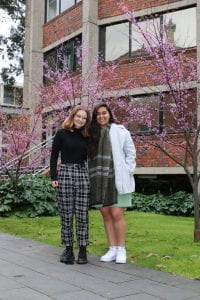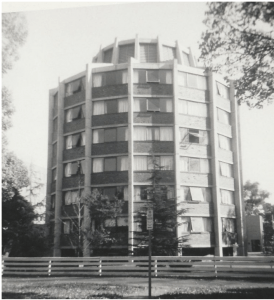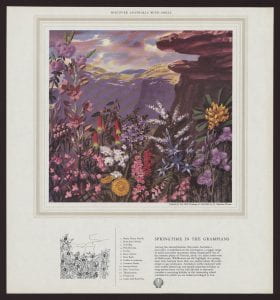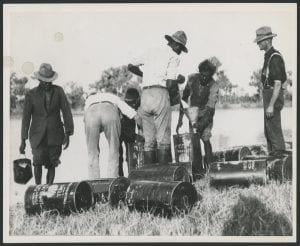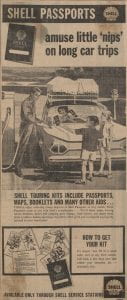Intern Conversations: Allegra McCormack and Larika Desai
Nguyen, Thu. Allegra (left) and Larika (right) at International House. 2021
Allegra McCormack and Larika Desai met through their Museums and Collections Project Program internship projects at International House, the second largest residential college at the University of Melbourne. Recently Allegra and Larika took the time to find out more about each other’s projects.
Larika: Allegra, how would you describe your project?
Allegra: I worked on the ‘Fifty Years of Women at International House (IH),’ as part of the Museums and Collections Projects Program. Utilising the IH archives and other contemporary sources I worked to create short biographies of the women who played key roles in the college’s foundation and development. As an undergraduate student majoring in history I was very excited for the opportunity to learn more about the history of International House and have the opportunity to work directly with primary sources to create an exhibition. The experience taught me a great deal not only about the processes behind archival work but about the history of IH and the University of Melbourne more broadly. Indeed, while the project was part of the commemoration of the fiftieth anniversary of female students being admitted to the college, I learnt that women have actually been closely involved in the history of IH since the very beginning.
Kathleen Sloane (left), Olive Wykes (centre) and Mabel Grimwade (right), Newspaper photograph. International House Archives, Melbourne, 1953
Larika: Why do you believe this project is important?
Allegra: I believe the stories of these women from across the IH community, whether patronesses, teachers or matrons, are a vital part of the college’s history. While their contributions were somewhat overlooked, the internal IH archives did reveal a network of passionate and diligent women who believed in the vision of International House and worked tirelessly to make it a reality. I feel very fortunate to have had the opportunity to write about these incredible women and help preserve their legacy. Whether high society patronesses, early college matrons or the first female students admitted in 1972, these women were a vital part of International House’s history and their influence continues to shape its future. I believe projects like this highlight how important it is to reinvestigate institutional histories and actively work to create a more inclusive and accurate historical record.
Larika: What were some of the challenges you faced? How did lockdowns affect your project?
Allegra: Like most of Melbourne, my 2021 plans were fairly disrupted by the changing lockdown conditions. I feel really lucky to have been able to have started my project placement in-person, however, I did have to shift to online work part way through. This change definitely made the work a little more difficult as I could no longer access the archives in-person or work onsite at the college. My supervisor Dr Caitlin Stone and everyone at IH was incredibly supportive during this period and helped make the transition to remote work a lot easier.
Nguyen, Thu. Newspaper clippings, International House Archives. 2021. Photograph.
Larika: What were some of the surprises you discovered during your placement?
Allegra: One of the more surprising things I kept coming across during the research process was how many women were referred to by only their husband’s name. Whether in newspapers or even some internal records, it could be quite challenging to uncover these women’s first names which did make further research quite difficult. While at first I felt a little naive to have not expected this kind of erasure of their individual identities, the discovery also made me feel very passionate about my project. I hope that creating biographies in celebration of the hard work undertaken by the women of IH will ensure their own lives will be better remembered.
Larika: Thanks for sharing Allegra
Allegra: Thanks Larika. Can you summarise your project placement for me?
Larika: Yes, my research project forms a part of the larger collaborative project of ‘Fifty Years of Women at International House (IH),’ being conducted at the residential college. It aims to understand and establish links between the House’s 1972 landmark decision of admitting women residents and the subsequent building of the Scheps wing. It places this in the wider context of the dismantling of the White Australia Policy, the women’s movement, the economic struggles of colleges and rampant architectural modernism. Organised through University of Melbourne’s Museums and Collections Projects Program (MCPP), it has themes of architectural history, archival research, cultural heritage and gender studies.
The Scheps building at International House. 1974. Photograph. International House Archives, Melbourne.
Allegra: Why was it important for you to research this aspect of International House’s history?
Larika: Project supervisor Dr Caitlin Stone and I are of the firm belief that it is important to shed light on such a significant moment of change, in the urban and cultural history of not just International House, but also the University of Melbourne. This project hopes to further our understanding of the decision-making at the time as a reflection of the existing social ideology and the oncoming shift in it.
As Scheps formed the backdrop to these incredible changes, it was important from an architectural history point of view to learn more about the building. The great social and emotional value attached to Scheps, gave the project the space to delve into values that people assign to buildings, which in turn helps to highlight the importance of heritage.
Allegra: How did the pandemic affect your ability to carry out your project work?
Larika: With constant lockdown interruptions, only part of the placement could be carried out on site at IH. Whilst onsite, it was great acquiring back of house insight into IH archives and being able to make visits to other relevant archives. The shift to online placement however, had its own learning challenges. Since I could not access any archives or libraries in person, I had to come up with innovative ways of doing desk-based research. I also had to rely heavily on information already digitised. Although it really varied as to how much staff was allowed to be on site and available, my contact persons were incredibly helpful. Everyone tried their best to make as much information as they could available, through virtual connection!
Allegra: What surprised you as you undertook your research?
Larika: The biggest insight has been into digitisation and learning that it is not a straightforward scan and send process. There are manifold procedures involved. For example, generating comprehensive metadata (descriptive data of records) is required prior to digitisation. There are also issues of copyright to be dealt with. Consequently, some collection materials are not even in compatible formats to be digitised. Doing this placement has made me more sympathetic to the processes involved and the hurdles to clear in order to make information digitally available, especially during times like lockdown when being onsite itself is a challenge.
Allegra McCormack, Bachelor of Arts
Larika Desai, Master of Urban and Cultural Heritage; Master of Architecture
